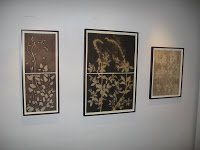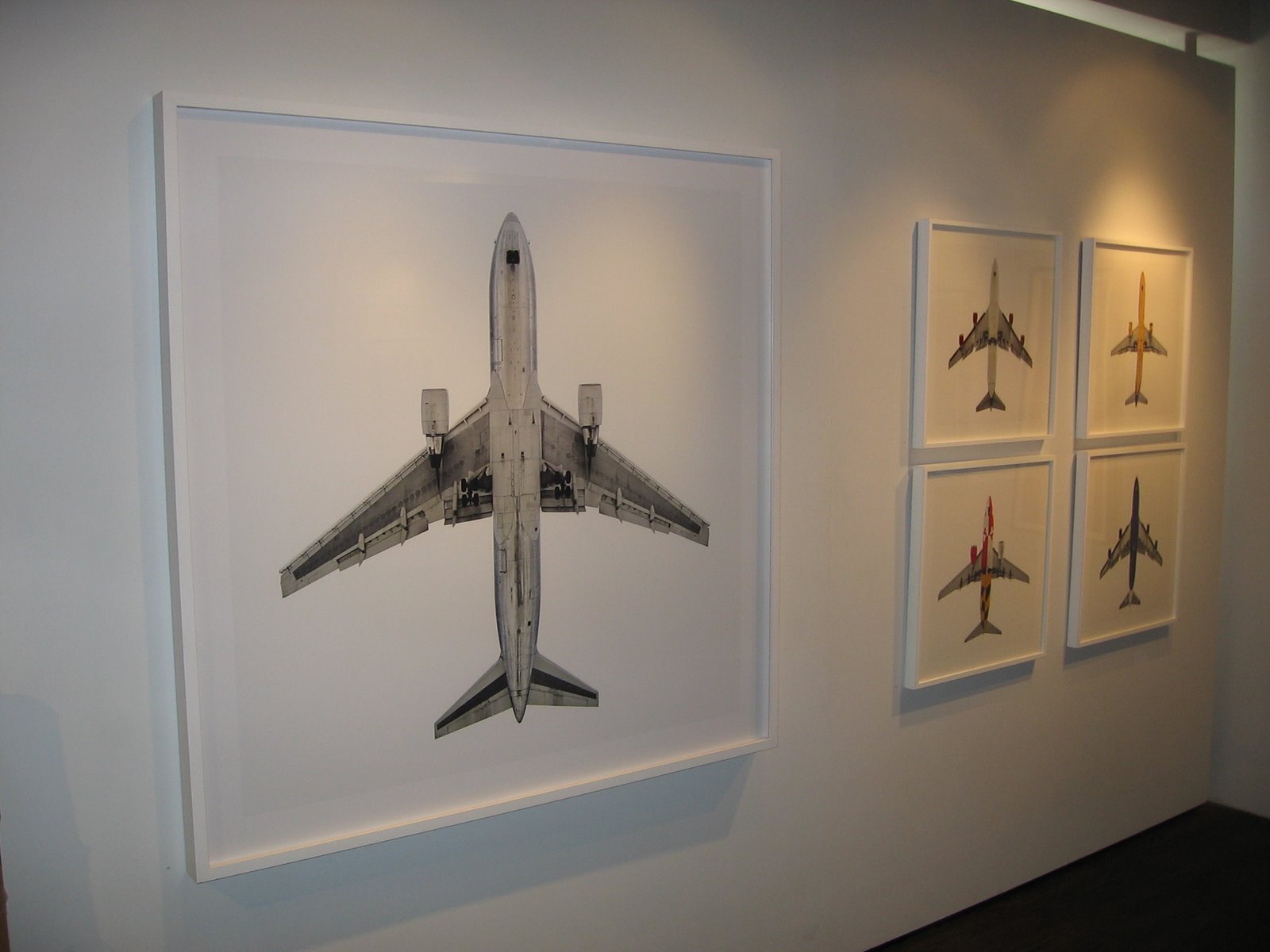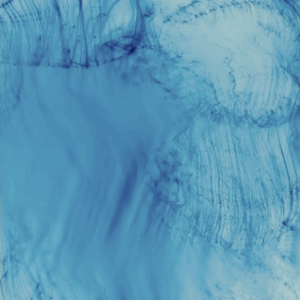JTF (just the facts): This is a group show of four gallery artists: Pamela Hanson, Peter C. Jones, Jeffrey Milstein, and Lindy Smith, shown in the entrance area and main gallery space. Here’s a quick rundown on each:
- Pamela Hanson: 14 images, 2 in color, the rest in black and white. Mostly of fashion/models. Ranging from 11×14 to 24×30.
- Peter C. Jones: 8 images, all in color, 20×20. Window scenes/florals/summer landscapes.
- Jeffrey Milstein: 7 images, all in color, varying sizes from 20×20 to 50×50. Images of airplanes from below and head-on, against white backgrounds.
- Lindy Smith: 5 works, some single images, some diptychs or triptychs. Floral Kallitypes
 Comments/Context: One of the big trends of the last decade has been, in the face of the relentless move to digital, the revival of many antique photographic processes, focusing on the hand crafted nature of image making. Artists have taken these old processes and applied them to new and different subject matter and come up with exciting new work that references the history of the medium.
Comments/Context: One of the big trends of the last decade has been, in the face of the relentless move to digital, the revival of many antique photographic processes, focusing on the hand crafted nature of image making. Artists have taken these old processes and applied them to new and different subject matter and come up with exciting new work that references the history of the medium.
Lindy Smith has taken an abandoned 19th process, the Kallitype, and resurrected it to make larger scale floral images. (see the installation photo at right.) The Kallitype is a cameraless process, where paper is coated with iron salts and silver nitrate and then exposed to the sun (much like the cyanotype, but with different chemistry). The interaction between the chemicals and the plants/flowers she lays down on the sheets creates some unpredictability in the final colors, generating a whole nuanced spectrum of browns, yellows and oranges. The resulting images are quiet, intricate, and lovely.
These pictures however raise for me a larger question about what happens when an artist heads down a path well worn by previous artists. Starting with William Henry Fox Talbot and Anna Atkins in the mid 19th century, and then moving forward to Bertha Jaques (see here) in the early 1900s (and many others since then), the concept of the simple silhouetted botanical image has been around for a long time, and these original artists set the standard and defined the playing field for everyone that has followed. How does an artist innovate and bring a new point of view to subject matter that has already be “done”?
In the world of music, we have seen the emergence of the “retro” and “neo” prefixes, attached to new work that either seeks to emulate the old sounds in full or to take those old sounds and recast them in a new light, while still staying recognizable as the old form. In Soul music, we might call Sharon Jones and the Dap Kings “Retro Soul” and someone like Amy Winehouse “Neo Soul”. Perhaps the artists themselves hate these kinds of characterizations, but these terms help audiences understand where the music is coming from and what it might be trying to accomplish.
So back to photography. Should we call Chuck Close’s recent portraits “Neo Daguerreoptyes“? No one would ever confuse what Close has done with portraits from the 19th century using the same medium; his artistic viewpoint is clear. Or what about these Lindy Smith florals? “Retro botanicals“? I wonder if her viewpoint comes through prominently enough; the works are clearly beautiful and well made, but are they a ground breaking new voice or a riff on the past? And if the artist’s perspective isn’t as strong or obvious, will “retro” style work stand the test of time? Will it be forgotten or enjoyed as something wonderfully familiar and comfortable?
In general, I like these Lindy Smith images for what they are and can imagine adding a small one to our collection. But go and check out the work yourself and make your own judgement.
Collector’s POV: The Lindy Smith works range in price from $3500 for the single images, up to $12000 for the triptychs, and of course, they are unique prints (edition of 1).
 As an aside, my eight year old son would love the work of Jeffrey Milstein in this show. (see installation photo at right.) This is meant as a high compliment, not a slight. My son would love the large, colorful shots of airplanes and would beg to have one in his room if he saw them in person. Ranging from $2600-6000 depending on size, that isn’t going to happen any time soon, but the works are striking and would work well in large contemporary spaces.
As an aside, my eight year old son would love the work of Jeffrey Milstein in this show. (see installation photo at right.) This is meant as a high compliment, not a slight. My son would love the large, colorful shots of airplanes and would beg to have one in his room if he saw them in person. Ranging from $2600-6000 depending on size, that isn’t going to happen any time soon, but the works are striking and would work well in large contemporary spaces.
Rating: * (1 star) GOOD (rating system defined here)
Four Summer
Through September 20th
Bonni Benrubi Gallery
41 East 57th Street
13th Floor
New York, NY 10022




